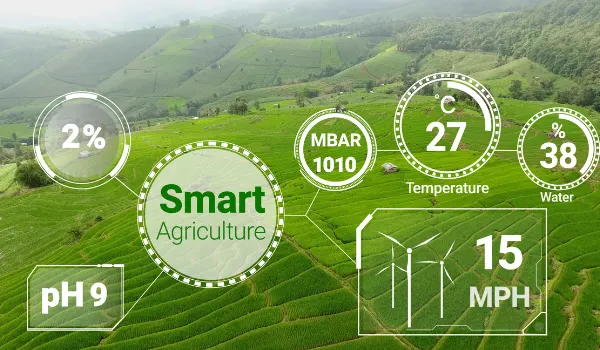The heart of India's economy is agriculture. It is the backbone of rural livelihood. In Jharkhand, where the farmers make up the population, agriculture is not just an income but a way of life. Weather conditions, poor access to markets, financial issues & inefficient distribution of government schemes. These are some of the challenges that the state is facing.
In recent years, digital technologies have emerged as a solution to many of these issues. Government initiatives are taken to create a digital infrastructure that has various aspects of the farming ecosystem. Beneficiary identification, land mapping, crop information, and scheme access are some of them. AgriStack, if implemented effectively, could be the answer to decades of inefficiency. Transforming farming from a gamble into a more predictable and profitable enterprise.
1. Overview
AgriStack is a comprehensive digital ecosystem built to change Indian agriculture. It’s not a single app or website, but rather a set of consistent digital systems. Aimed at streamlining data collection, governance, and service delivery across all agricultural sectors.
At the centre of AgriStack there are three components:
- Each farmer receives a Farmer ID linked to their Aadhaar. This ID ensures that government schemes reach the right individuals without any delay.
- Every farm plot is mapped and tagged using satellite imagery and GPS coordinates. This resolves ownership disputes and ensures accurate input delivery.
- This registry tracks real-time data about what is being cultivated, when, and where. This helps in forecasting yield, market demand, and even disaster management.
All of this data is accessible through the Unified Farmer Service platform. That connects banks, insurers, agritech startups, and government agencies with authenticated farmer profiles. Whether it's giving a KCC loan, offering crop insurance, or delivering weather advisories. UFSI enables personalised, fast, and data-driven service delivery.
AgriStack is still evolving, but in Jharkhand, traditional farming practices dominate.State support is not there; it has begun to create an ecosystem of opportunity. By digitising & decentralising power into the hands of farmers.AgriStack stands to redefine what farming looks like in the 21st century.
Read More: Perovskite Solar Boosts Renewable Energy in Jharkhand
2. Jharkhand’s agricultural landscape
The topography, climate and the socio-economic structure of Jharkhand make up its agricultural landscape. More than 75 per cent of the population in the state is rural. And nearly 60 per cent of the workforce depends on agriculture. Yet, the state contributes less than 2 per cent to India’s total food grain production.
The reasons are complex:
- Mechanisation is hard due to small and scattered landholdings.
- The climate is very reliant on rainfall as more than 90 per cent of arable land is rainfed. Farmers are left vulnerable to monsoon changes.
- Low adoption of modern technology has kept productivity low.
- Inadequate infrastructure such as storage facilities, irrigation, and roads increases post-harvest losses.
A large sum of the farming community comprises tribal and marginal farmers. They often lack access to institutional credit, government schemes, and formal markets.
That’s where AgriStack has the potential to make a tangible difference. By digitising land records, creating farmer profiles, and enabling scheme delivery without intermediaries. It also empowers policymakers to make better decisions. In regard to subsidy allocation, crop procurement, and climate risk management.
For Jharkhand, a state still developing its agri-infrastructure. AgriStack is not just a reform; it is a reinvention.
3. In Action
It's starting to transform the agricultural ecosystem on the ground:
1. Easier Access to Government Schemes
Earlier, availing benefits under PM-KISAN, crop insurance (PMFBY), or soil health schemes. They required endless paperwork and multiple visits to government offices. Once a farmer registers, their eligibility is verified through linked databases. Payments now arrive digitally in their bank accounts on time and without middlemen.
2. Improved Access to Credit
In a state where only half of the farmers have formal credit access. It enables auto-processing KCC by verifying land ownership and cropping patterns digitally. It used to take weeks, but now it can be filtered in hours.
3. Real-Time Advisory & Weather Alerts
Farmers like Sukhlal Oraon living in the district of Gumla now receive SMS alerts. Alerts like that on weather patterns, sowing advice, and pest forecasts.
4. Market Linkages
By enrolling in the electronic National Agriculture Market. Farmers can now get updates about the price and can then sell to various markets. After cutting out local middlemen and increasing income.
5. Digitised Land Records
Land ownership conflicts are almost ending in rural areas. With digital land mapping, boundaries can now be seen on mobile. Reducing legal battles and enabling smooth inheritance transitions.
Read More: Drone Farming Technology Empowering Agriculture in Jharkhand
4. The Technology Behind
AgriStack is more than just a database; it’s a technology heap. Designed to bring agriculture to even distant farms. Here’s how:
- Bhuvan and ISRO’s geospatial mapping provide accurate layouts of land parcels. Which includes the soil type, slope, and irrigation potential.
- In future versions, AgriStack will enable smart sensors. To monitor field moisture, temperature, and pest activity, creating a true “smart farm”.
- Through UFSI, even agri-tech startups can build mobile apps or services.Which will be tailored to Jharkhand’s local conditions.
With smartphones and village digital assistants, the tools are no longer out of reach.
5. Challenges
As promising as AgriStack is, the rollout in Jharkhand faces several real challenges:
- Digital Divide: Many villages still lack 4G internet access. Older farmers, especially women, are less aware about smartphones.
- Consent and Privacy: So much personal & financial data is involved. The absence of data protection law raises concerns about misuse by private companies.
- Language and Literacy Barriers: Most digital platforms are in Hindi or English. Localised content is crucial.
- Infrastructure Gaps: Without investment in connectivity, digital tools alone won’t improve incomes.
Nevertheless, the overall reaction of the grassroots workers is guardedly optimistic. AgriStack is imperfect, but better than what we had, and according to one Krishi Mitra of Giridih.
Conclusion
Agri Stack is a radical move towards equity, efficiency and empowerment in Indian agriculture. The problems in Jharkhand are both localised and intractable. It brings a digital connection to a strong, information-driven, and lucrative agricultural future. There is still a lot of work to do but the initial results indicate quiet revolution. In the state’s farmlands powered not by fancy machinery, but by information and access.













